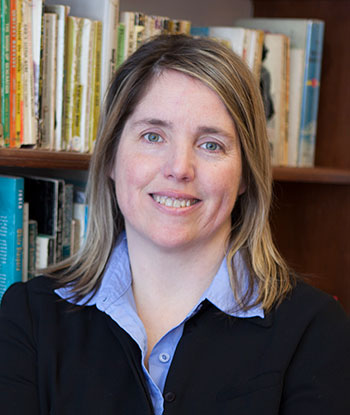Pulteney Street Survey
On decolonizing the canon and the relationships between storytelling and social change
by Anna Creadick
Professor of English

Decolonizing the canon is an ongoing process of interrogating what and who we teach, and why. Sometimes this process is about thinking about race and representation. But sometimes it is about gender, nationality, or other kinds of colonizing forces. In my recent “American Women Writers” course, I talked explicitly with my students about the pressure and power I feel in selecting the first text we read, because “who speaks first” inevitably constructs a genealogy, the starting point to the “story” of the course topic. Whose voice counts? Who sets the stage? In that course, I began with Incidents in the Life of a Slave Girl to make explicit the fact that all the categories of my course title — “American” and “woman” and “writer” — would have been troubled ones for enslaved women. So Harriet Jacobs’ narrative was a triple threat. I closed the course with Janet Mock’s memoir of her experience as a trans woman of color, because I wanted to engage this moment of gender-expansiveness, while also showing how autobiography and citizenship and selfhood are still being linked in our literature.
I think about the canon most intensely in my “Modern American Literature” course, which is basically a 20th century survey. In this course, students meet writers they have heard of like Hemingway, Fitzgerald, or Faulkner. But they also read best-selling and celebrated immigrant writers like Anzia Yezierska, or read the early science fiction of W.E.B. duBois, or read protest fiction by writers of the 1930s like Tillie Olsen. This year, I concluded the course with Chester Himes’ If He Hollers, Let Him Go, and we were all shaken by the parallels between this racial protest novel of 1945 and the current environment of struggle for racial justice. Even after the class concluded, I had to send the students a note on Canvas to share the news story about the white woman who threatened to call the police on the Black bird-watcher in Central Park, because the race/gender/power dynamics of that threat were nearly exactly the ones that doomed the Black protagonist of Himes’ novel, whose life is ruined by a white woman experimenting with her power.
Sometimes, especially in first-year courses, what I am trying to do is help students to develop a new set of questions. Teaching about race through the lens of “whiteness” helps destabilize many students’ sense of familiarity with the subject. They think they have studied race, but then we come at the subject from a different angle, one that many of them, especially white students, have not thought about very deeply. They come to realize “whiteness” has a specific and traceable history.
My “Literature and Social Movements” course is basically designed as a cultural history course — we begin with abolitionism and move through the 20th century — but we always conclude with a contemporary example that speaks to our moment…Most recently, #BLM has been the social movement most urgently on their radar, so we have read works like Claudia Rankine’s Citizen or Danez Smith’s Don’t Call Us Dead to think about what role literature can or could play. For their final projects, students select their own topics, and it is always powerful to see which contemporary issues concern them: gun violence, climate justice, animal rights. But some students also want to look more closely at historic topics that have deep resonance with their current moment. For example, they will research the rise of the KKK, or the impact of countercultures like the Beats or Riot Grrrl, or the impact of AIDS activism. For them to understand the relationships between narrative/storytelling and social change not only helps contextualize what is happening today as part of an ongoing struggle, but it also helps them think about how social change is driven by different kinds of engines. Some people are marching in the streets, but others might be having difficult conversations or grinding out posters or pamphlets or poems.
“Southern Fictions” is another class that allows us to talk about tough issues like oppression, structures of domination, and discrimination, but to locate those discussions on the relatively (for most students) distant territory of the U.S. South. The literature coming out of that region is some of the most incredible writing that we have, so it is always a powerful class because of the themes that writers like William Faulkner, Carson McCullers, Flannery O’Connor, or Alice Walker bring to the surface. For a long time, I ended that course with an anthology called The Ringing Ear: Black Poets Lean South, because it just explodes not only all the questions and issues we had been considering, but also explodes the South itself as a kind of social construct and national scapegoat. By the end of the course, many students have had to confront their own regional bias. But most recently, I concluded with contemporary African-American author Jesmyn Ward, whose novel Sing, Unburied, Sing just totally devastated us. As a class, we were left reeling, thinking about how structural racism can destroy families, about the violence and injustice of the prison system, about the accrual of trauma in African-American bodies, but also about the resilience of black youth and the magical possibilities of better futures.
